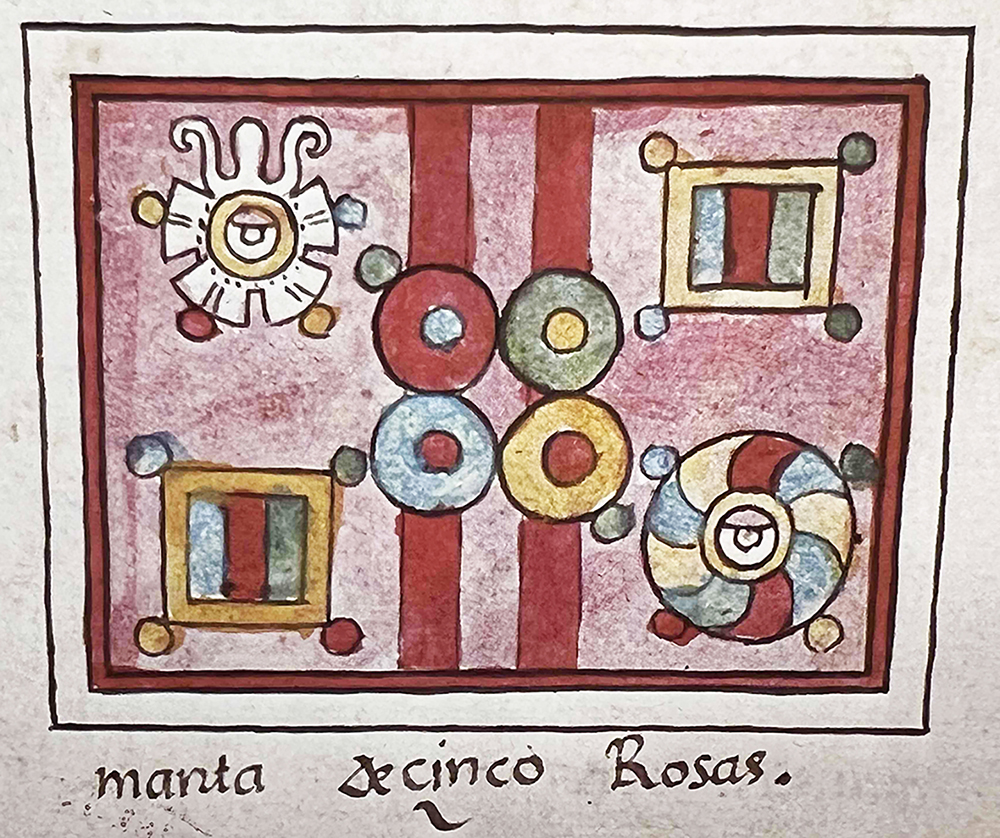tonalli (Mglb4v)
tonalli (Mglb4v)
This element for a day or the sun [tonalli) has been carved from a cloak featuring five flowers in the Magliabechi Codex.. This glyph for “day” is the central one of the five “flowers.” Note how it compares favorably to the glyph for tonalli from the Codex Mendoza (below). Here, it consists of four circles of different colors, each one containing a smaller, concentric circle of yet a different color. The upper left circle is red with a blue center. The upper right circle is green with a yellow center. The lower left circle is blue with a red center. The lower right circle is yellow with a red center. On the upper left perimeter of the red circle is a small green circle. Another small green circle appears on the lower right perimeter of the yellow circle. If one were to connect these four perimeter circles, the result would be a large X, forming a quincunx. Two vertical red bands run behind the four large circles, one underneath the red and blue circles and one underneath the green and yellow circles. This all appears on a pink background.
Stephanie Wood
This element for a day or the sun appears on a page in the Magliabechi Codex where a cloak with a “Five Flower” design (Macuilxochitl) is featured. This glyph is one of the “flowers,” and yet it strongly resembles the tonalli hieroglyph from the Codex Mendoza (below). As the contextualizing image shows, another one of the “flowers” is also the hieroglyph echoed in the Codex Mendoza as ilhuitl (day). Macuilxochitl is a day sign in the calendar that has an association with the deity Xochipilli and tonaleque, which explains why this “flower” is also therefore a “tonalli."
Stephanie Wood
Jeff Haskett-Wood
days, días, calendarios, calendars, time, tiempo, flores

tonal(li), day, sun, https://nahuatl.wired-humanities.org/content/tonalli
ilhui(tl), day, https://nahuatl.wired-humanities.org/content/ilhuitl
Macuilxochitl, Five Flower, https://nahuatl.wired-humanities.org/content/Macuilxochitl
Images of the Magliabechi Codex are hosted by FAMSI at http://www.famsi.org/research/graz/magliabechiano/index.html. They were taken from the Codex Magliabechiano CL. XIII.e (B.R. 232) published in 1970 by Akademische Druk - u. Verlagsanstalt - Graz. This is the best facsimile available.
We are borrowing less than 10% of the images from this manuscript. The details from the Magliabechi Codex that are shared here fall under a Creative Commons Attribution-Non-Commercial-ShareAlike 4.0 International (CC BY-NC-SA 4.0) license. Please only reproduce these images for non-profit and educational purposes, and if you do reproduce an image, please site the FAMSI website, http://www.famsi.org/research/graz/magliabechiano/index.html, and the Visual Lexicon of Aztec Hieroglyphs, https://aztecglyphs.wired-humanities.org/.



